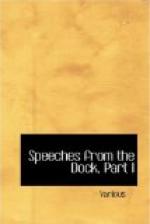Thither was the Commission now sped, to carry terror, if the “strong arm of the law” could do it, into the hearts of those conspirators “against the royal name, style, and dignity” of her Majesty Queen Victoria. As no one in the Castle could say to what desperate expedients those people might have recourse, it was thought advisable to take extraordinary precautions to ensure the safety of the train which carried those important personages, her Majesty’s judges, lawyers, witnesses and informers, through the Munster counties and on to the city by the Lee. “Never before” writes the special correspondent of the Nation, “had such a sight been witnessed on an Irish railway as that presented on Thursday along the line between Dublin and Cork. Armed sentries paced each mile of the railway; the platforms of the various stations through which the trains passed were lined with bodies of constabulary, and the bridges and viaducts on the way were guarded by a force of military, whose crimson coats and bright accoutrements stood out in bold relief from the dark ground on which they were stationed, against the grey December sky. As a further measure of precaution a pilot engine steamed in advance of the train in which their lordships sat, one carriage of which was filled with armed police. And so, in some such manner as Grant or Sheridan might have journeyed along the Petersburgh and Lynchburg railway while the flag of the Confederacy floated in Richmond, the two judges travelled down in safety to the head-quarters of Fenianism in Munster.”
Immediately on their arrival in Cork, the judges proceeded to the court-house and formally opened the business of the Commission. Next day Charles Underwood O’Connell and John M’Afferty were placed in the dock. These two men belonged to a class which formed the hope of the Fenian organization, and which the government regarded as one of the most dangerous elements of the conspiracy. They were Irish-American soldiers, trained to war, and inured to the hardships of campaigning in the great struggle which had but recently closed in America. They were a sample of the thousands of Irishmen who had acquired in that practical school the military knowledge




